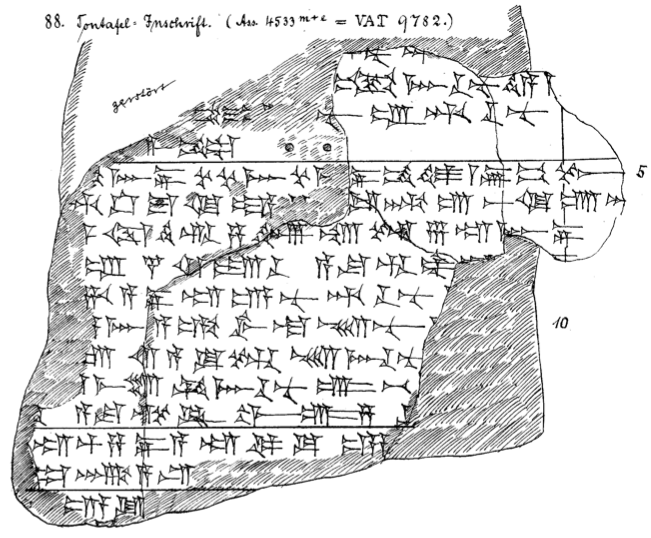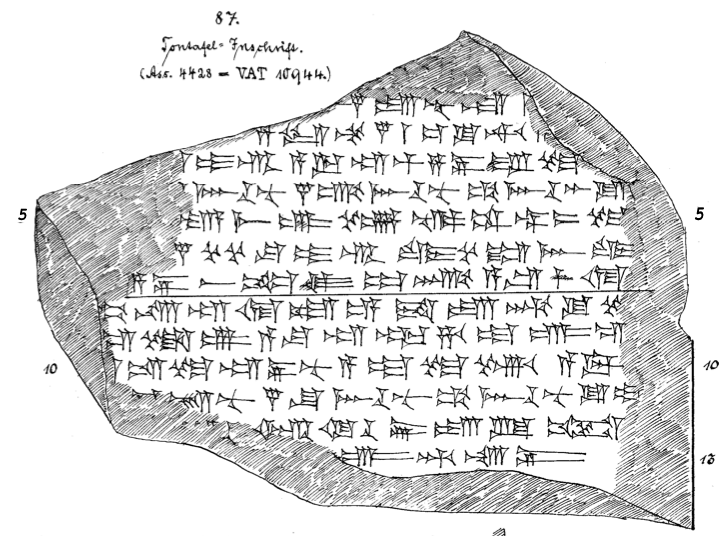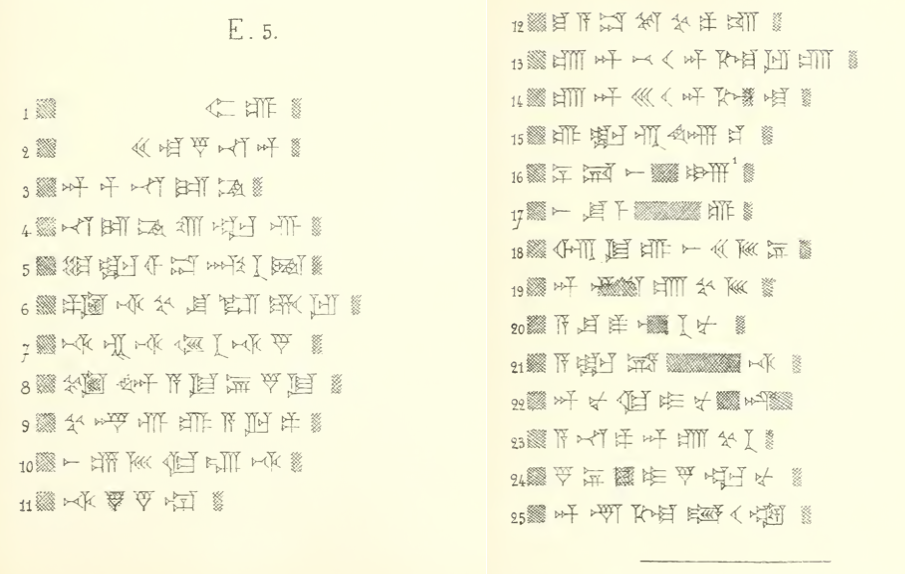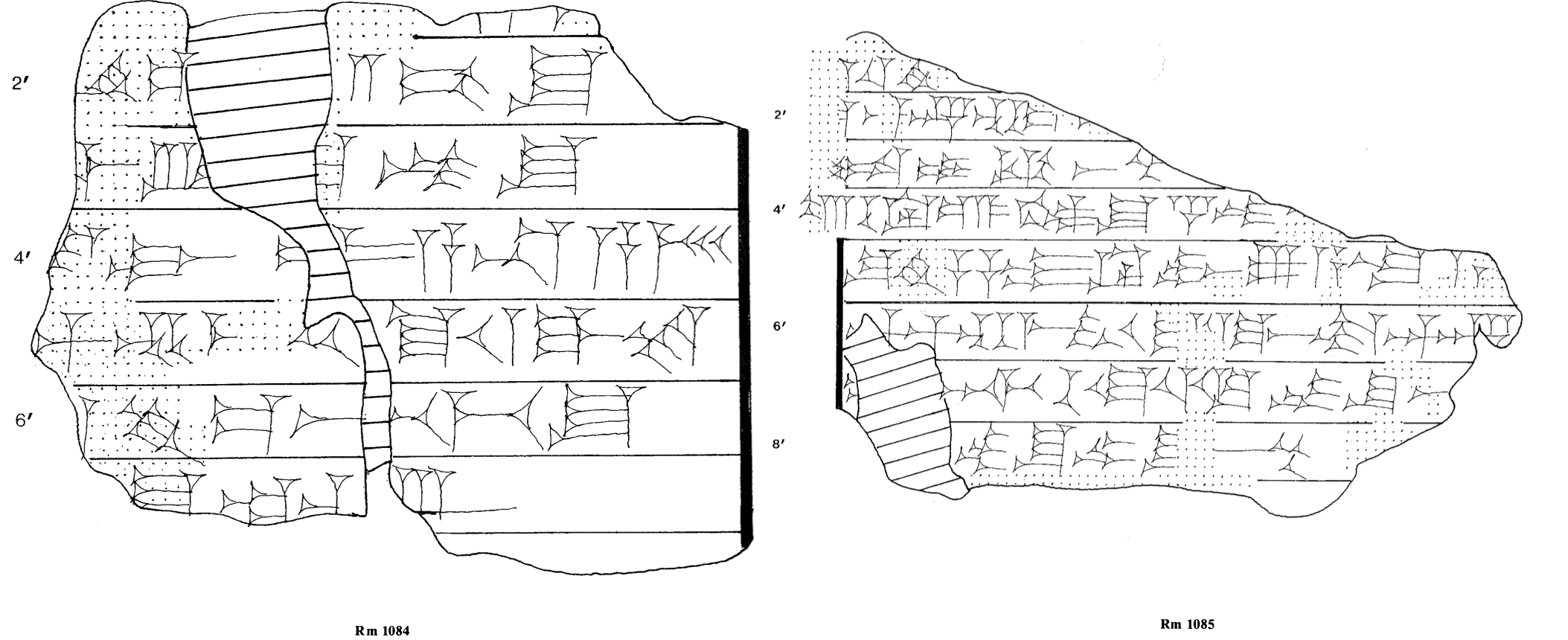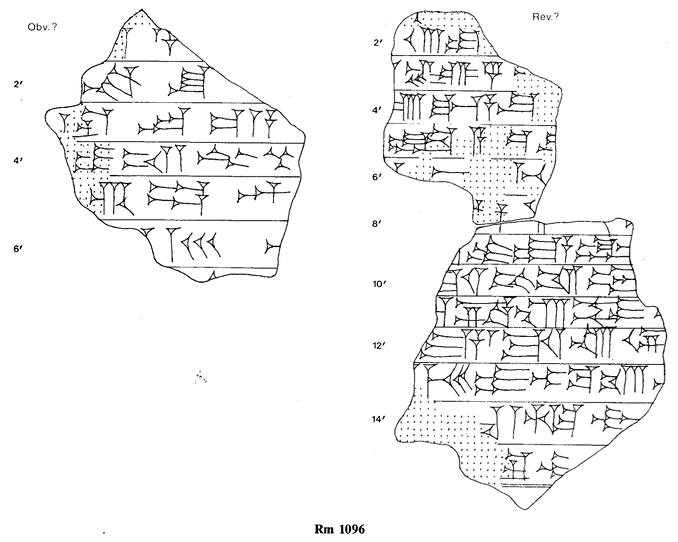Quick links
The Standard Inscription
(no. 23)
Rassam Obelisk (no. 24)
Lion statues (no. 28)
Banquet Stele (no. 30)
Statue of Ashurnasirpal II
(no. 39)
Browse the RIAo Corpus [http://oracc.museum.upenn.edu/riao/pager/]
20
21
22
23
24
25
26
27
28
29
30
31
32
33
34
35
36
37
38
39
20
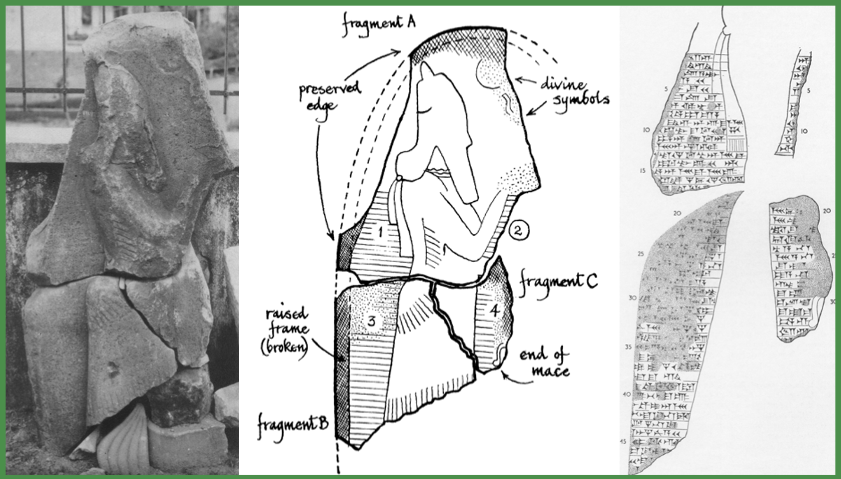
Elaboration from Hawkins, AnSt 19 pp. 111-20
A number of stone stele fragments have been found in the village of Babil, in southeastern Turkey near the border with Syria, and are now stored in the Adana museum, where J. D. Hawkins has examined and collated the inscription. According to K. Kessler, Lehmann-Haupt mentioned a fragment which seems to have disappeared.
An invocation to the gods similar to the one on text no. 17 (Nimrud Monolith) opens the inscription (lines 1-14a) and is followed by name, titles and genealogy of Ashurnasirpal. This part is parallel to text no. 1 i 18b-34, from which many restorations have been made. The narration is then missing, although Grayson (RIMA 2, p. 262) suggests that it must have recorded a campaign along the Upper Tigris, in the area of modern Babil.
Access the composite text [http://oracc.museum.upenn.edu/riao/Q004474/] of Ashurnasirpal II 20.
Source: Lehmann-Haup, Mat. pl. 1
Bibliography
1906 Lehmann-Haupt, Mat. pp. 19-22 and pl. I (photo, study)
1969 Arnaud, RHA 27/84-85 pp. 41-49 (edition)
1969 Hawkins, AnSt 19 pp. 111-20 (photo, copy, edition)
1973 Schramm, EAK 2 pp. 21 and 35 (study)
1976 Grayson, ARI 2 CI 12 (translation)
1980 Kessler, Nordmesopotamien pp. 35-37 (study)
1982 Börker-Klähn, Bildstelen nos. 133-34 (study)
1991 Grayson, RIMA 2 A.0.101.20 p. 262-264 (edition)
21
Two clay tablets from Ashur are inscribed with an annalistic text. The discovery of exemplar 2 has provided the necessary evidence to allow Grayson ascribing the inscription to Ashurnasirpal (RIMA 2, p. 265).
Access the composite text [http://oracc.museum.upenn.edu/riao/Q004475/] of Ashurnasirpal II 21.
Sources:
(1) VAT 09752 (Ass 02551)
(2) VAT 09782 (Ass 04533e + Ass 04533m)
Bibliography
1922 Schroeder, KAH 2 no. 88 (ex. 2, copy)
1926 Luckenbill, ARAB 1 §§397 and 399 (ex. 2, translation)
1935 Seidmann, MAOG 9/3 p. 7 (ex. 2, study)
1967 Borger, HKL 1 p. 473 (ex. 2, study)
1972 Grayson, JNES 31 p. 217a (ex. 2, study)
1973 Schramm, EAK 2 pp. 3 and 8 (exs. 1-2, study)
1976 Grayson, ARI 2 XCVIII 6 (translation)
1986 Pedersén, Archives 2 p. 24 no. 79 (ex. 2, provenance)
1991 Grayson, RIMA 2 A.0.101.21 p. 265-266 (edition)
22
A fragment of clay tablet from Ashur bears an annalistic text which could be ascribed to one king between Aššur-dān II and Ashurnasirpal II, the latter considered more probable by Grayson (RIMA 2, p. 267).
Access the composite text [http://oracc.museum.upenn.edu/riao/Q004476/] of Ashurnasirpal II 22.
Source: VAT 10944 (Ass 04428)
Bibliography
1922 Schroeder, KAH 2 no. 87 (copy)
1926 Luckenbill, ARAB 1 §§397-98 (translation)
1935 Seidmann, MAOG 9/3 p. 7 n. 1 (study)
1961-62 Dossin, AAAS 11/12 p. 201 (study)
1967 Borger, HKL 1 p. 473 (study)
1972 Grayson, JNES 31 p. 217 (study)
1973 Schramm, EAK 2 pp. 7-8 (study)
1976 Grayson, ARI 2 CI 71 (translation)
1986 Pedersén, Archives 2 p. 22 no. 50 (provenance)
1991 Grayson, RIMA 2 A.0.101.22 p. 266-267 (edition)
23 - "Standard Inscription"
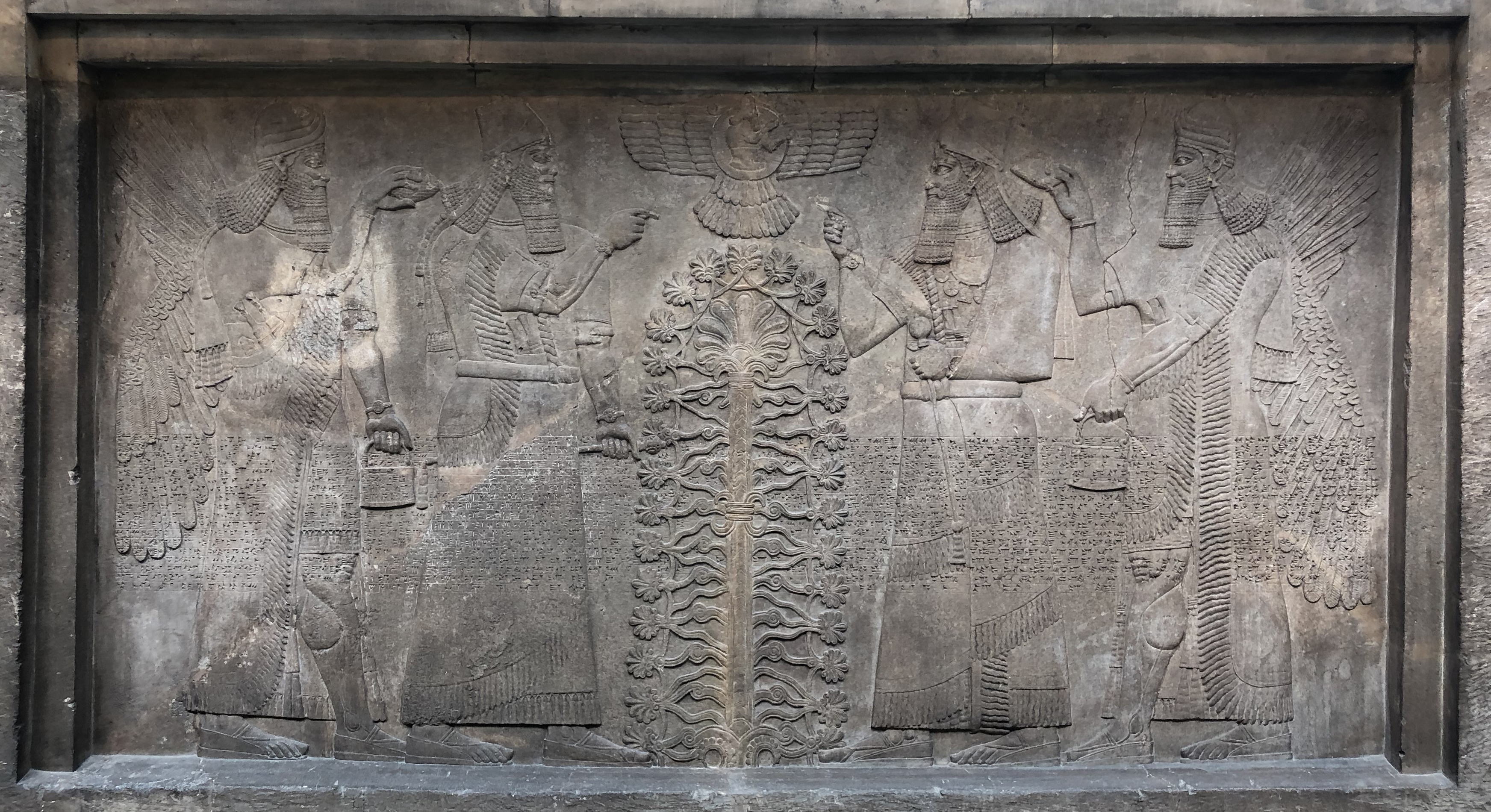
North West Palace, Slab B-23, BM 124531 (ex. 27) © The Trustees of the British Museum
The so-called "Standard Inscription" of Ashurnasirpal is an inscription engraved on more than four hundred exemplars, including all the big sculpted reliefs in limestone that lined the walls of the North West Palace at Nimrud. Each orthostat was inscribed with the same text, which occupied the central part of all of them, so that the impression would be of a single continuous inscription running through all the walls of the palace. Some of the slabs are "tripartite," with a central band for the inscription and upper and lower registers of sculpted reliefs. However, in most cases the inscription is carved over the sculpted central portion of the reliefs (see image above). Also because of its importance in the general arrangement of the palatial architecture, this is one of the most famous texts of the Neo-Assyrian period, which has been studied from multiple different levels of analysis, e.g., the historical context of its creation, the process of production, in the framework of the relationships between text and images.
On the Oracc platform, there are two projects where one can find useful information about the Standard Inscription:
A brief but exhaustive introduction to the text is the one by
Jonathan Taylor, 'The Standard Inscription of Assurnasirpal II',
Nimrud: Materialities of Assyrian Knowledge Production, The Nimrud
Project at Oracc.org, 2015, click here [/nimrud/livesofobjects/standardinscription/index.html] to access the page.
J. Caleb Howard has created a project which offers the complete
scores (more than four hundred exemplars!) of the Standard
Inscritpion. Click here [/asn2/] to access
The Royal Inscriptions of Ashur project.
Access the composite text [http://oracc.museum.upenn.edu/riao/Q004477/] of Ashurnasirpal II 23.
Sources:
(1) IHA 1
(2) Private Collection: Aleppo, Syria
(3) AC S.1855.2 + MIA 41.9
(4-5) AC -
(6) AC S.1855.6 + WAH 1917.083
(7) AO 19.845
(8) AO 19.846
(9) AO 19.847
(10) AO 19.848 + CSM 8
(11) AO 19.851
(12) Ashm 1982-0224
(13) [Deleted exemplar]
(14) BCM 0588-065
(15) BM 090760 (1979-12-20, 0338)
(16) BM 098062 + WM 1889
(17) BM 098063
(18) BM 098064
(19) BM 102400
(20) BM 102487 + Copenhagen AS 01
(21) BM 108836 (1914-04-07, 0002)
(22) BM 118804
(23) BM 118875
(24) BM 118906
(25) BM 118930
(26) BM 124530
(27) BM 124531
(28) BM 124532 + BM 124533
(29) BM 124534 + BM 124535
(30) BM 124536 + BM 124537
(31) BM 124538 + BM 124539
(32) BM 124540 + BM 124541 + Nimrud -
(33) BM 124542 + BM 124543 + Nimrud -
(34) BM 124544 + BM 124545
(35) BM 124546 + BM 124547
(36) BM 124548 + BM 124549
(37) BM 124550 + BM 135736 + MCAL 1 + IB 00015 + CFE - + Nimrud 20
(38) BM 124551 + BM 124552
(39) BM 124553 + BM 124554 + K 08543 K 08543
(40) BM 124555 + BM 124556
(41) BM 124557 + BM 124558
(42) BM 124559
(43) BM 124560 + WAE 44.1927
(44) BM 124562
(45) BM 124563
(46) BM 124564
(47) BM 124565
(48) BM 124566
(49) BM 124567
(50) BM 124568
(51) BM 124569
(52) BM 124575
(53) BM 124576
(54) BM 124577
(55) BM 124579
(56) BM 124581 + ROM 939.011.002
(57) BM 124584
(58) BM 124585
(59) BM 124586
(60) BM 139983 (1983-01-01, 0344)
(61) BM 139984 (1983-01-01, 0345)
(62) BM 139999 (1983-01-01, 0351)
(63)CSM 2 + Nimrud 69–71 + Nimrud 78–79
(64) CSM 3
(65) Mumbai VAM 77
(66) Me.487
(67) Me.489
(68) Haskell Coll. 1860.1 + 64.EA.3 + WAH 1955.101
(69) Haskell Coll. 1860.5
(70) H-0794
(71) H-0795
(72) H-0796
(73) 55.145
(74) 55.147
(75) 55.148
(76) 55.153
(77) 55.154
(78) 55.155
(79) 55.156
(80) FMV 1
(81) CAM 1962.14
(82) AS 03 + 186:1925
(83) AE.I.N. 1723 + Nimrud 25–28
(84) Herrmann-Verzeichnis 19
(85) Herrmann-Verzeichnis 21
(86) Herrmann-Verzeichnis 22
(87) NMS A.1956.362
(88) WAE 45.1927
(89) Erm -
(90) Erm - + B 1939/2.1
(91) Erm -
(92) AGM 1369 (28/35) + MMA 1932.143.11 + Nimrud 29
(93) HM S.856.3.02
(94-96) HM -
(97) HM S.856.3.36
(98-99) HM -
(100) HM - + MMA 1931.72.1
(101) IB 14989
(102) IM -
(103) IM - + MVat -
(104) Ist Nimrud 0004
(105) Ist Nimrud 0005
(106) Ist Nimrud 0006
(107) Ist Nimrud 4649
(108) Ist Nimrud -
(109) K 08887
(110) WRNG 1
(111) M.71.073.01
(112) M.71.073.03a
(113) M.71.073.03b
(114) Meuszyński, Bag, For. 2 p. 24 B-29
(115) Meuszyński, Bag, For. 2 p. 30 C-c-1
(116) Meuszyński, Bag, For. 2 p. 30 C-c-2
(117) Meuszyński, Bag, For. 2 p. 30 C-c-3
(118) Meuszyński, Bag, For. 2 p. 30 C-c-4
(119) Grayson, Ladders pp. 123-125
(120) MGC 118
(121) Iraq LPS 1 + Nimrud 32
(122) LPS 2
(123) LPS 3
(124) LPS 4
(125) Lyon 531
(126) Iraq VII-A-8 + Nimrud 61
(127) MFAB 1935.0731
(128) MFAB 1935.0753
(129) MFAB 1881.0056
(130) MCV 0.114
(131) MMA 1931.72.2
(132) MMA 1931.72.3
(133) MMA 1932.143.04
(134) MMA 1932.143.06
(135) MMA 1932.143.07
(136) MMA 1932.143.08
(137) IMM 003
(138) IMM -
(139) Gl. WAF 3
(140) Gl. WAF 5
(141) Gl. WAF 7 + Nimrud 06
(142) 82152a–b
(143) Nimrud 24 + VA 00938
(144) Nimrud 30 + Nimrud 31 + Nimrud 33 + WCMA 1851.2
(145) Nimrud 34
(146) Nimrud 35 + Nimrud 36
(147) Nimrud 62
(148) Nimrud 63–68 + Nimrud 77 + MRAH O.1934
(149) Nimrud 81–82
(150) Nimrud 85
(151) Nimrud 86
(152) MRAH O.0270
(153) MRAH O.0272
(154) MRAH O.0273
(155) MRAH O.0274
(156) MRAH O.0275
(157) MRAH O.0277
(158) Paley and Sobolewski, Bagh. For. 10 p. 48 S-c-3
(159) Meuszyński, Bagh. For. 2 p. 28 C-2
(160) Paley, Ashur-nasir-pal p. 59
(161) Stockholm 856
(162) StBi 03972
(163) UM 29-21-001
(164) VA 00939a
(165) VA 00939b
(166) VA 00939c
(167) VA 00940
(168) VA 00942
(169) VA 00943
(170) VA 00944
(171) VA 00945
(172) VA 00946
(173) VA 00947
(174) VA 00948a
(175) VA 00948b
(176) VA 00951
(177) VA 00952
(178) VA 00959
(179) VA 03863
(180) WAM 21.0008
(181) WCMA 1851.1
(182) Worcester 1930.32
(18) YBC 02445
(184) ZhArchSlg 1910
(185) ZhArchSlg 1911
(186) ZhArchSlg 1912
(187) ZhArchSlg 1913
(188) Nimrud - + AC S.1855.1 + MCO - + Nimrud 41 + YU 01854.3 + YU 01854.4 + YU 01854.5
(189) Nimrud - + AO 19.849 + AO 22.198 + BM 098061 + DIA 47.181 + Nimrud 42 + Nimrud 43 + Nimrud 45
(190) Nimrud - + AO 19.868 + F-8
(191) Nimrud - + Ashm 1950-241 + Copenhagen AS 02+ IM -
(192) Nimrud - + Ashm 1982-0225 + F-9 + Nimrud 48
(193) Nimrud - + Bern 12.2.63
(194) Nimrud - + BM 102401
(195) Nimrud - + BM 108833
(196) Nimrud - + BM 118803
(197) Nimrud - + BM 118874 + A -
(198) Nimrud - + BM 118876 + BM 118877
(199) Nimrud - + BM 118921 + F-10 + Private Collection (Samuel Josefowitz) + Nimrud 49
(200) Nimrud - + BM 118926 + BM 118927
(201) Nimrud - + BM 118928 + Nimrud 07–08
(202) Nimrud - + BM 124561
(203) Nimrud - + BM 124563
(204) Nimrud - + BM 124574 + CSM 9 + IM - + IM - + IM -
(205) Nimrud - + BM 124578
(206) Nimrud - + BM 124580 + Houston 80.53 + Nimrud 40
(207) Nimrud - + BM 124582 + IM - + IM - + IM - + IM - + IM -
(208) Nimrud - + BM 124583 + Bryn Athyn 09.SP.1549 + Ist Nimrud 0022 + Nimrud 46
(209) Nimrud - + BM 135156 + Nimrud 38
(210) Nimrud - + CSM 1
(211) Nimrud - + Haskell Coll. 1860.2
(212) Nimrud - + Haskell Coll. 1860.4 (Me.490)
(213) Nimrud - + Private Collection + Hamburg 1965, 101 + Nimrud 58–59a–b
(214) Nimrud - + Brooklyn 55.146
(215) Nimrud - + Brooklyn 55.149
(216) Nimrud - + Brooklyn 55.150
(217) Nimrud - + Brooklyn 55.151
(218) Nimrud - + Brooklyn 55.152
(219) Nimrud - + Me.491.2
(220) Nimrud - + A 00001 + Nimrud 55–57
(221) Nimrud - + CCC -
(222) Nimrud - + Cleveland 43.246
(223) Nimrud - + AE.I.N. 1491
(224) Nimrud - + AE.I.N. 1491a
(225) Nimrud - + Herrmann-Verzeichnis 20
(226) Nimrud - + WAE 01.1908 + IM -
(227) Nimrud - + WAE 02.1908 + MMA 1932.143.12
(228) Nimrud - + WAE 03.1942
(229) Nimrud - + Erm - + Erm - + MMA 1932.143.14 + Nimrud 53 + MN 193335
(230) Nimrud - + IM 028143
(231) Nimrud - + Ist Nimrud 7037 + IM 029059
(232) Nimrud - + IM - + Santa Barbara -
(233) Nimrud - + IM - + CMA 56.22
(234) Nimrud - + Ist Nimrud 7036
(235) Nimrud - + AP 81.4a
(236) Nimrud - + AP 81.4b
(237) Nimrud - + MMA 1917.190.2077 + MMA 1917.190.2078
(238) Nimrud - + MMA 1917.190.2079
(239) Nimrud - + MMA 1917.190.2080 + MMA 1917.190.2081
(240) Nimrud - + MMA 1917.190.2082
(241) Nimrud - + MMA 1932.143.03
(242) Nimrud - + Gl. WAF 1
(243) Nimrud - + Gl. WAF 2
(244) Nimrud - + Gl. WAF 4
(245) Nimrud - + Private Collection (New York) + IAM -
(246) Nimrud - + Nimrud 01
(247) Nimrud - + Nimrud 03–05
(248) Nimrud - + Nimrud 11–17
(249) Nimrud - + Nimrud 18–19 + MRAH O.0278
(250) Nimrud - + Nimrud 21–22
(251) Nimrud - + Nimrud 44 + MAG 44.10 + MVat 14989
(252) Nimrud - + Nimrud 47 + Nimrud 51
(253) Nimrud - + Nimrud 50 + CMA 56.49.1a
(254) Nimrud - + Nimrud 52 + ACC - + ROM 950.006.001
(255) Nimrud - + Nimrud 54 + Nimrud 80 + 89a–d
(256) Nimrud - + Nimrud 60 + Nimrud 73–76
(257) Nimrud -
(258) Nimrud - + Nimrud 88 + YU 1854.1
(259) Nimrud - + MRAH O.0271
(260) Nimrud - + Princeton 207
(261) Nimrud - + VA 00941
(262) Nimrud - + VA 00949
(263) Nimrud - + VA 00950
(264) Nimrud - + VA 08747
(265) Nimrud - + Va.1
(266) Nimrud - + WAM 21.9
(267) Nimrud - + YU 1854.2a–b
(268-300) Nimrud -
(301) IM 029053 + Nimrud -
(302-406) Nimrud -
(407) Tyndale 22
(408) MHAM 0001.A(a).SV II
(409) USA MHAM 0002.A(a).SV II
(410) MHAM 0003.A(a).SV II
(411) NCMI 004
(412) DIA 50.032
(413) ROM 910.092.054 D1110
(414) HMA 9-01762 + HMA 9-01762a + HMA 9-01763
(415) 2010-06-22, 0019
(416) ZhArchSlg 1915
(417) E54113
(418) E05608
Bibliography
1851 Layard, ICC pls. 1-11 (text)
1902 King, AKA pp. 212-21 (text)
1907 Le Gac, Asn. pp. 152-70 (text)
1926 Luckenbill, ARAB 1 §§485-89 (text, translation)
1973 Schramm, EAK 2 pp. 39-42 (text)
1976 Grayson, ARI 2 CI 13 (text, translation)
1976 Meuszyński, Arch. Anz. (objects)
1976 Paley, Ashur-nasir-pal (objects, text)
1977 de Filippi, Assur 1/7 pp. 123-69 (text)
1980 Asher-Greve, Genien und Krieger pp. 12-30 (objects, text)
1981 Meuszyński, Bagh. For. 2 (objects)
1981 Reade, Iraq 43 pp. 145-56 (objects)
1981 Sobolewski, ZA 71 pp. 248-73 (objects)
1983 Winter, Essays Wilkinson pp. 15-32 (objects, text)
1985 Reade, Iraq 47 pp. 203-214 (objects, text)
1987 Paley and Sobolewski, Bagh. For. 10 (objects, text)
1989 Porter, Assyrian Bas-Reliefs at the Bowdoin College Museum of Art (objects, text)
1991 Grayson, RIMA 2 A.0.101.23 p. 268-276 (edition)
24 - "Rassam Obelisk"
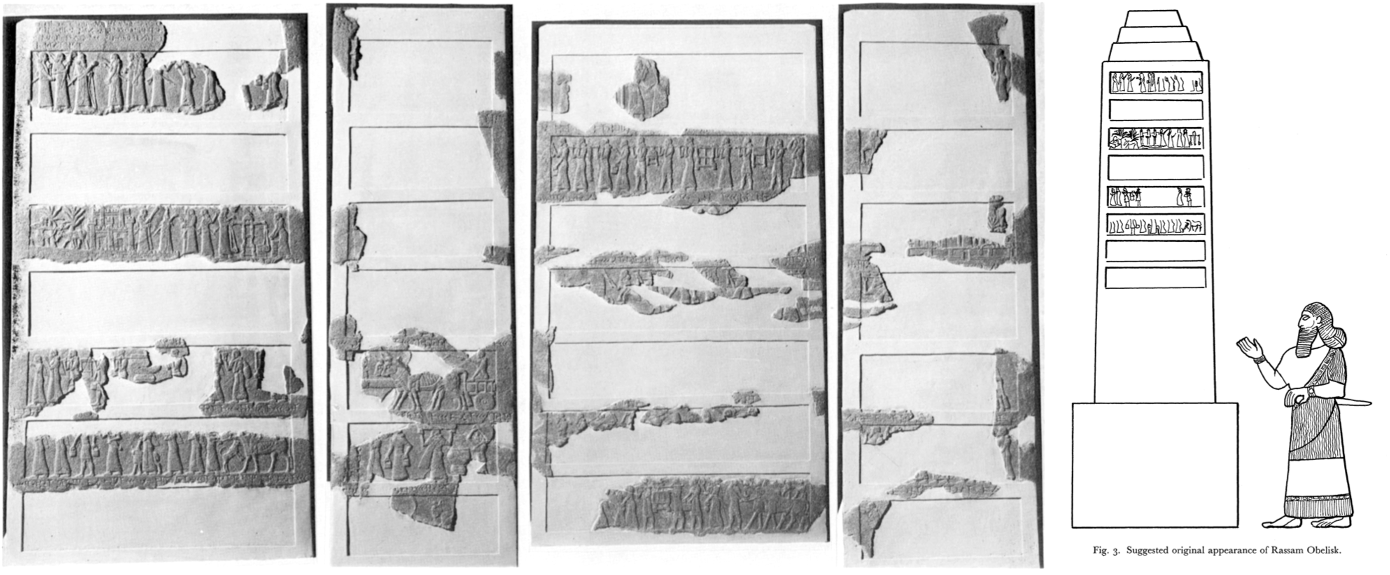
BM 090925 + BM 118800 + BM 132013 (from
Reade (and Walker), Iraq 42 Pl. I and p. 6) © The Trustees of the British Museum
Several pieces of black stone with remains of reliefs and inscriptions found by H. Rassam at Nimrud are part of a obelisk belonging to Ashurnasirpal II. In the late Seventies of the twentieth century, the members of the Department of Western Asiatic Antiquities at the British Museum have provided a reconstruction of the original position of the fragments and J. Reade has published a complete study on the monument in 1980 (see bibliography below).
The fragments were found in the so-called "Central Building," where
the obelisk had been deliberately broken into pieces in antiquity
(perhaps Hellenistic times). The reconstruction of the obelisk shows
that it had originally scenes in reliefs depicting numerous subjects
of tribute of the Assyrian ruler, accompanied by a series of captions
indicating the identity of each tribute bearer. At the top of the
monument was still preserved a small portion of the original
inscription, which seems to have been a version of the "Standard Inscription." Fragments of a similar obelisk, possibly also to be ascribed to Ashurnasirpal II, had been found at Ashur (text no. 1004).
The preserved captions of the obelisk are edited here as nos. 71-78

Main inscription; Reade (and Walker), Iraq 42, Pl. II
Access the composite text [http://oracc.museum.upenn.edu/riao/Q004478/] of Ashurnasirpal II 24.
Source: BM 090925 + BM 118800 + BM 132013
Bibliography
1897 Rassam, Asshur pp. 11-12 (provenance)
1907 Le Gac, Asn. pp. 207-209 (copy)
1936 Gadd, Stones pp. 128-29 and pl. 6 (photo, study)
1962 Barnett and Falkner, Tigl. pp. 1-7 (provenance)
1969 Pritchard, ANEP2 pl. 290 fig. 350 (photo)
1976 Grayson, ARI 2 CI 70 (study)
1980 Reade (and Walker), Iraq 42 pp. 1-22 (photo, edition)
1982 Börker-Klähn, Bildstelen no. 138 (photo, study)
1991 Grayson, RIMA 2 A.0.101.24 p. 277-278 (edition)
25
A squeeze of a stone object from Nimrud was referred to by Le Gac in his edition of Ashurnasirpal II's inscriptions as a duplicate of various lines from text no. 23: lines 1-5 (but ending with UGU DÙ-ši-na KUR.KUR.MEŠ "over all countries"), and final lines 14-22 (starting with URU kal-ḫu maḫ-ra-a "the ancient city of Kalḫu"). The squeeze is, hoever, now destroyed (see RIMA 2, pp. 191-192), and no edition can be provided.
Source: E 089 (squeeze)
Bibliography
1907 Le Gac, Asn. p. 165 E.89 (study)
1973 Schramm, EAK 2 p. 43 (study)
1976 Grayson, ARI 2 CI 13b (study)
1991 Grayson, RIMA 2 A.0.101.25 p. 278 (edition)
26
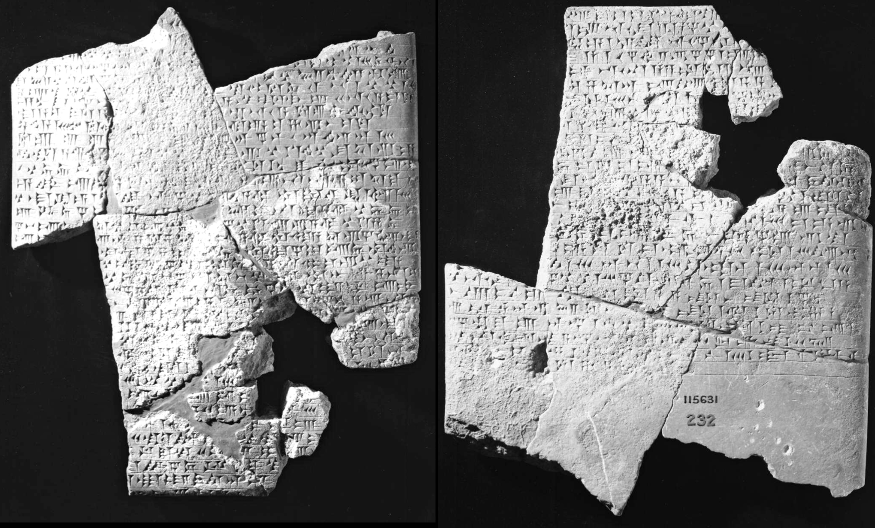
BM 115631 (ex. 16) © The Trustees of the
British Museum.
Several foundation stone tablets were found in different places (in secondary contexts) at Nimrud. The tablets bear all a text that offers a more detailed description of the construction of the so-called "North West Palace" (lines 64b-72). The text is introduced (lines 1-58a, cf. the parallel passage in text no. 1 iii 113b-136) by the name, titles and genealogy of the king with a description of his conquests in geographical, rather than temporal, order (cf. text no. 54). The mention of "the city Carchemish of the land of Ḫatti" (line 22) instead of "Mount Lebanon and the Great Sea" as the western limit of Ashurnasirpal's reign makes this inscription earlier than most of the annalistic texts of this ruler. Some, but not all, of the exemplars ends with concluding blessings and curses.
Access the composite text [http://oracc.museum.upenn.edu/riao/Q004480/] of Ashurnasirpal II 26.
Sources:
(1) BM 090868
(2) BM 090867
(3) BM 090915
(4) Ashm 1951-0061 (ND 00816)
(5) IA - ND 01121
(6) IM 055745 (ND 00817)
(7) IM 060498 (ND 06232)
(8) ND 06233
(9) IM 060635 (ND 06234)
(10) ND 06235
(11) ND 06236
(12) Rm 1086 + Rm 1087 + Rm 1088 (+) Rm 1089
(13) IM - (ND 00201)
(14) DUROM N -
(15) Rm 1090
(16) BM 115631 (Rm 2, 607)
(1*) Rm 1091
Bibliography
1902 King, AKA pp. 177-88 (exs. 1-3, copy, edition)
1926 Luckenbill, ARAB 1 §§507-513 (exs. 1-3, translation)
1950 Wiseman, Iraq 12 p. 187 (ex. 13, provenance)
1951 Wiseman and Kinnier Wilson, Iraq 13 p. 118 (exs. 4, 6, provenance)
1952 Wiseman, Iraq 14 p. 66 (ex. 5, provenance)
1966 Mallowan, Nimrud 1 pp. 114-15 (exs. 4, 6, provenance); 2 p. 395 and n. 39 (exs. 7-11, provenance)
1967 Borger, HKL 1 p. 218 (study)
1973 Postgate, Governor's Palace pp. 211-12 and pl. 74 no. 217 (ex. 13, copy, edition)
1973 Schramm, EAK 2 pp. 43-44 (study)
1976 Grayson, ARI 2 CI 14 (exs. 1-16, translation)
1991 Grayson, RIMA 2 A.0.101.26 p. 278-282 (edition)
27
A squeeze of a stone object from Nimrud was referred to by Le Gac in his edition of Ashurnasirpal II's inscriptions as a duplicate of text no. 23: 1-13 (ending with mu-la-iṭ ek-ṣu-te "encircler of the obstinate"), and of text no. 1 iii 127-128 (ending with DU.DU-ku-ma> "has always acted"). This arrangement of the text makes it a parallel of text no. 26. The squeeze is, hoever, now destroyed (see RIMA 2, pp. 191-192), and no edition can be provided.
Access the composite text [http://oracc.museum.upenn.edu/riao/Q004481/] of Ashurnasirpal II 27.
Source: E 024 (squeeze)
Bibliography
1907 Le Gac, Asn. p. 165 E.24 (study)
1973 Schramm, EAK 2 p. 43 (study)
1976 Grayson, ARI 2 CI 13a (study)
1991 Grayson, RIMA 2 A.0.101.27 p. 282-283 (edition)
28
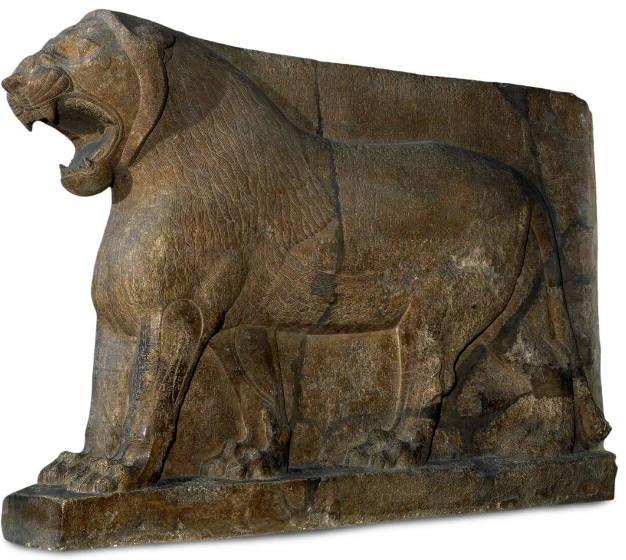
BM 118895 © The Trustees of the
British Museum.
Two stone monumental lions standing at the entrance of the temple of the goddess Šarrat-nipḫi in Nimrud present an inscription on their obverse (edited here) and one on their reverse (see text no. 32). The text, which is a duplicate of parts of texts no. 1 and/or 23 begins with a dedication to the goddess followed by royal name and titles in a very similar way to text no. 1; this first part occupies the entire first column of the inscription. Columns ii 1- iv 13 are inscribed with a description in geographical order of the conquests of Ashurnasirpal II, which is parallel to text no. 1 iii 114-125. It follows (v 1-6) a description of the construction works at Nimrud (= text no. 1 iii 132-134) and of various temples of the same city (cf. text no. 29: 13'-23' and no. 30: 53-77). The inscription is concluded by a section of blessings.
Access the composite text [http://oracc.museum.upenn.edu/riao/Q004482/] of Ashurnasirpal II 28.
Sources:
(1) BM 118895
(2) IMM -
Bibliography
1902 King, AKA pp. 206-208 (ex. 1, copy, edition)
1907 Le Gac, Asn. pp. 181-86 (ex. 1, copy)
1914 Budge, Sculptures pl. VI (ex. 1, photo)
1926 Luckenbill, ARAB 1 §§521-24 (ex. 1, translation)
1936 Gadd, Stones pp. 126-27 (exs. 1-2, provenance)
1953 von Soden, SAHG pp. 259-60 (ex. 1, translation)
1966 Mallowan, Nimrud 1 p. 92 (ex. 2, provenance)
1973 Schramm, EAK 2 pp. 44-45 (ex. 1, study)
1975 Postgate, Iraq 37 pp. 58-59 (ex. 2, study)
1976 Grayson, ARI 2 CI 15 (exs. 1-2, translation)
1991 Grayson, RIMA 2 A.0.101.28 p. 283-286 (edition)
29
A squeeze of an inscription originally from Nimrud, but from an unknown object, was published by Le Gac. The text present passages parallel to text no. 28. Only part of the last lines of the last line of the introduction is preserved (an invocation to a god). It follows a section of name and titles of the king and a description of Ashurnasirpal's conquests (lines 2'-8') and a description of the construction works at Nimrud (lines 9'-17'). The text ends with blessing and curses.
Access the composite text [http://oracc.museum.upenn.edu/riao/Q004483/] of Ashurnasirpal II 29.
Source: Le Gac pp. 195–196
Bibliography
1907 Le Gac, Asn. pp. 195-96 (copy)
1973 Schramm, EAK 2 pp. 45-46 (study)
1976 Grayson, ARI 2 CI 16 (translation)
1991 Grayson, RIMA 2 A.0.101.29 p. 286-287 (edition)
30 - Banquet Stele
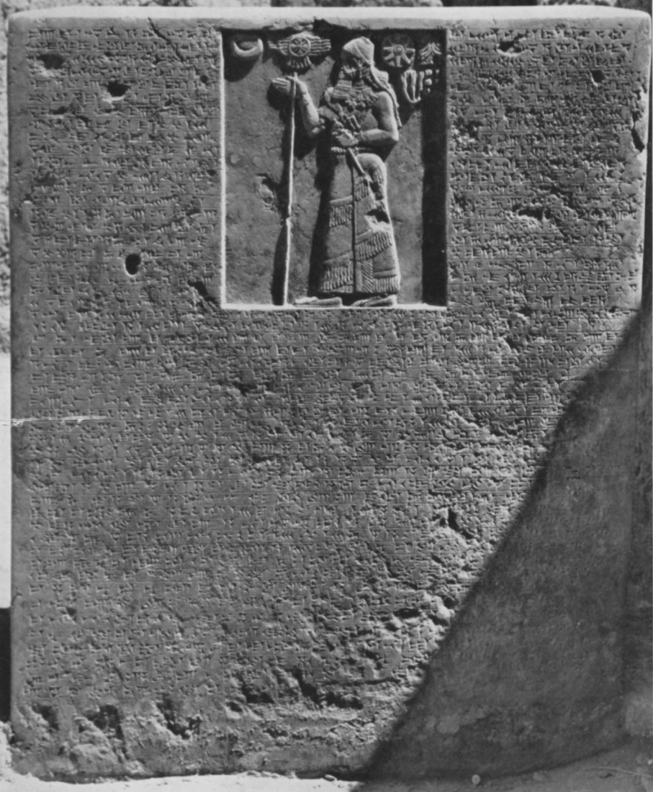
IMM - (ND 01104) © The Trustees of the
British Museum.
A large stone slab (104.5 x 128 cm) was found in the North West Palace at Nimrud during one of the expeditions of the British School of Archaeology in Iraq led by M. Mallowan on the site. The originality of this text lays in the fact that it records the menu for the lavish banquet held for the dedication of the same palace were the stele was discovered (lines 102-154). This part comes after a historical introduction that corresponds to an abbreviated version of Ashurnasirpal II's "Standard Inscription," and a detailed description of the construction works at Nimrud, including a detailed list of the names of different species of trees imported and planted by the Assyrian ruler in his new capital.
Access the composite text [http://oracc.museum.upenn.edu/riao/Q004484/] of Ashurnasirpal II 30.
Source: IMM - (ND 01104)
Bibliography
1952 Wiseman, Iraq 14 pp. 24-44 and pls.II-VI (photo, copy, edition)
1963 J. Laessoøe, People of Ancient Assyria (London) pp. 103-106 (translation)
1966 Mallowan, Nimrud 1 pp. 57-73 (provenance, study)
1968 Brinkman, PKB pp. 186-87 and 391 n. 2188 (study)
1969 Oppenheim, ANET3 pp. 558-60 (translation)
1973 Schramm, EAK 2 pp. 36-39 (study)
1973 Postgate, Governor's Palace pp. 238-40 (study)
1976 Grayson, ARI 2 CI 17 (translation)
1982 Börker-Klähn, Bildstelen no. 137 (photo, study)
1991 Grayson, RIMA 2 A.0.101.30 p. 288-293 (edition)
31
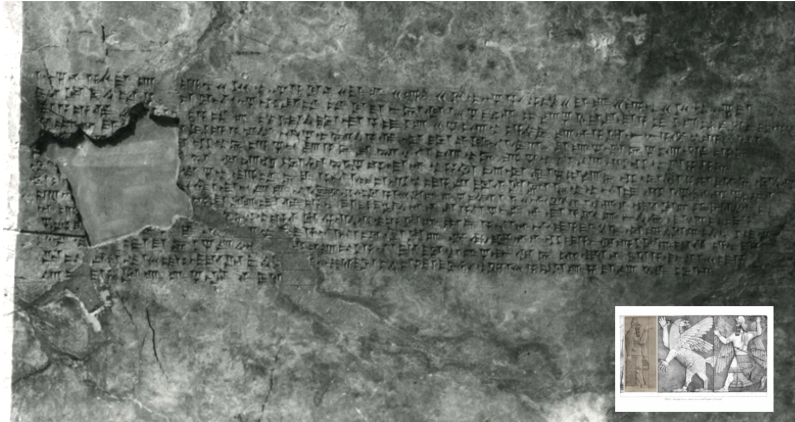
BM 124571 © The Trustees of the
British Museum.
The present inscription is engraved on the backs of three large stone slabs which were originally mounted adjacent to one another at the entrance of the temple of Ninurta in Nimrud. To see the texts on the obverse, go to texts nos. 5-7. A further inscribed slab was next to text no. 3. The inscription begins with name and epithets of the king, a description of the construction works at Nimrud (parallel to text no. 1 ii 125-135). There is then a specific reference to the dais of the god Ninurta. The text ends with a prayer to Ninurta.
Access the composite text [http://oracc.museum.upenn.edu/riao/Q004485/] of Ashurnasirpal II 31.
Sources:
(1) BM 124571
(2) BM 124572
(3) BM 124573 (cast: BM 124589)
Bibliography
1902 King, AKA pp. 209-11 (ex. 3, copy, edition)
1926 Luckenbill, ARAB 1 §525 (ex. 3, translation)
1973 Schramm, EAK 2 p. 44 (ex. 3, study)
1976 Grayson, ARI 2 CI 18 (exs. 1-3, translation)
1977 de Filippi, Assur 1/7 pp. 139-46 (exs. 1-3, edition)
1991 Grayson, RIMA 2 A.0.101.31 p. 293-295 (edition)
32
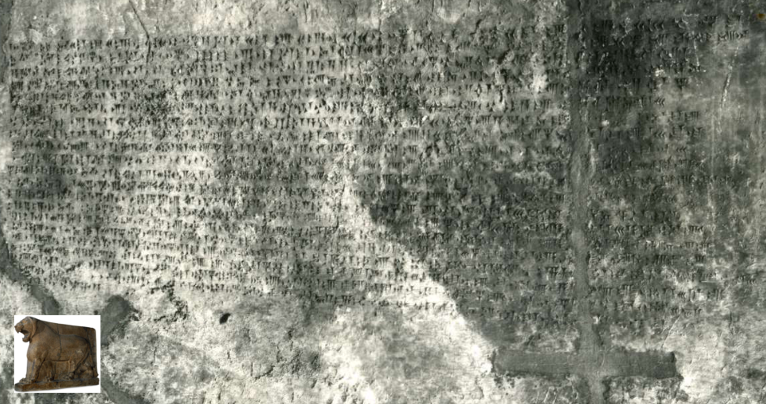
BM 118895 © The Trustees of the
British Museum.
This text was inscribed on the back part of the statue of a lion standing at the entrance of the temple of the goddess Šarrat-nipḫi in Nimrud (text no. 28). The inscription is carelessly written with a number of scribal errors. The text starts with king's name, titles and genealogy (lines 1-7a). It follows a description (parallel to the similar passage of the Standard Inscription, text no. 23: 8b-11a) of Ashruansirpal's conquests in geographical order. It then describes the construction works on the temples of Šarrat-nipḫi, Ninurta, Gula and Sîn at Nimrud, with detailed description of the creation of a statue of Ištar and its dais destined to the temple of Šarrat-nipḫi.
Access the composite text [http://oracc.museum.upenn.edu/riao/Q004486/] of Ashurnasirpal II 32.
Source: BM 118895
Bibliography
1985 George and de Filippi, ARRIM 3
pp. 18-20 [/arrim/downloads/arrim3/arrim3-6.pdf] (edition)
1991 Grayson, RIMA 2 A.0.101.32 p. 295-297 (edition)
33
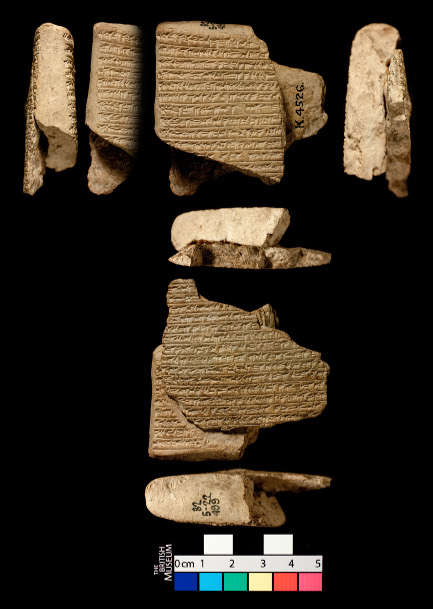
K 04526 + 1882-05-22, 0499 © The Trustees of the
British Museum.
A clay tablet fragment stored at the British Museum bears a royal inscription. The tablet can be either a pattern for or a copy from a monumental inscription. The text, after name, titles and genealogy of the king, and summary of his conquests, concerns the construction works at Nimrud, but with some important differences with the other monumental inscriptions from Nimrud, and with some resemblance to texts coming from Nineveh. The Kuyunjik number on the tablet does not proof without doubt its provenance from Nineveh, but a provenance from central Assyria is anyway most probable. The text is fragmentary in the end, although it clearly has a blessings and curses section.
Access the composite text [http://oracc.museum.upenn.edu/riao/Q004487/] of Ashurnasirpal II 33.
Source: K 04526 + 1882-05-22, 0499
Bibliography
1907 Le Gac, Asn. pp. 194-95 (copy)
1973 Schramm, EAK 2 p. 52 (study)
1975-76 Schramm, WO 8 pp. 39-43 (copy, edition)
1976 Grayson, ARI 2 p. 115 n. 468 b v (study)
1991 Grayson, RIMA 2 A.0.101.33 p. 297-299 (edition)
34
Several stone slabs from the North West Palace at Nimrud bear this text, which is, for its most part, a duplicate of text no. 1 ii 125-132a, but with the sentence "I founded therein my royal palace," instead of the description of the works on the Ninurta temple.
Access the composite text [http://oracc.museum.upenn.edu/riao/Q004488/] of Ashurnasirpal II 34.
Sources:
(1) BM 090982
(2) BM 090979
(3) BM 092985
(4) RC 1801
(5) WAGM 375
(6) KC -
Bibliography
1902 King, AKA pp. 173-76 (exs. 1-3, copy, edition)
1926 Luckenbill, ARAB 1 §§505-506 (exs. 1-3, translation)
1941 Jones, AJSL 58 p. 326 (ex. 5, study)
1973 Dombrowski, RA 67 pp. 131-45 (ex. 6, photo, edition)
1976 Grayson, ARI 2 CI 22 (exs. 1-3, 5, translation)
1991 Grayson, RIMA 2 A.0.101.34 p. 299-300 (edition)
35
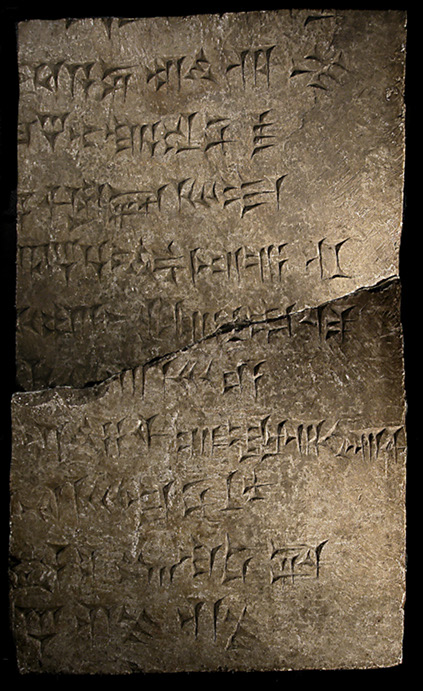
WAGM 373 + WAGM 374 © The Trustees of the
British Museum.
Several stone slabs originally coming from the North West Palace at Nimrud bear an inscription that has a lot of similarities with texts nos. 23 and 34, with a description of the building of Nimrud and its palace. The introduction, instead, is parallel to yet another text, no. 32: 1-7a.
Access the composite text [http://oracc.museum.upenn.edu/riao/Q004489/] of Ashurnasirpal II 35.
Sources:
(1) BM 098066 (1903-10-12, 0004)
(2) E 365 (squeeze)
(3) E 375 (squeeze)
(4) E 325 (squeeze)
(5) E 380 (squeeze)
(6) E 021 (squeeze)
(7) L 564
(8) L 566
(9) WAGM 373 + WAGM 374
(10) MRAH O.0276
(11) Private Collection
Bibliography
1894 Le Gac, ZA 9 p. 390 (exs. 7-8, study)
1907 Le Gac, Asn. pp. 166-68 (exs. 2-8, copy)
1922 BM Guide p. 71 (ex. 1, study)
1925 Speleers, Recueil no. 326 (ex. 10, study)
1941 Jones, AJSL 58 p. 326 (ex. 9, study)
1976 Grayson, ARI 2 CI 23 (exs. 2-9, translation) and p. 115
n. 468 a, v (ex. 1, study)
1991 Grayson, RIMA 2 A.0.101.35 p. 301-302 (edition)
36
Two fragments of stone slabs from Nimrud bear this inscription, which although no name is preserved can be fairly certainly ascribed to Ashurnasirpal II. Only the concluding formulae are preserved, but it is probable that the building mentioned was the temple of Ninurta. It is possible that text no. 37 was part of the same text.
Access the composite text [http://oracc.museum.upenn.edu/riao/Q004490/] of Ashurnasirpal II 36.
Sources:
(1) Rm 1085
(2) Rm 1084
Bibliography
1976 Grayson, ARI 2 CI 24 (exs. 1-2, translation)
1988 Grayson, ARRIM 6
pp. 23-24 [/arrim/downloads/arrim6/arrim6-7.pdf] (exs. 1-2, copy)
1991 Grayson, RIMA 2 A.0.101.36 p. 302-303 (edition)
37
A small part of a text on a stone slab fragment from Nimrud comes almost certainly from Ashuransripal II's inscriptions. In fact, it is possible that it was part of text no. 36. However, not enough is preserved to warrant an edition.
Source: Rm 1096
Bibliography
1988 Grayson, ARRIM 6 pp. 23-24 [/arrim/downloads/arrim6/arrim6-7.pdf](copy)
1991 Grayson, RIMA 2 A.0.101.37 p. 303 (study)
38
One complete inscription and several portions of texts from fragmentary stone tablets bear this text, whose introduction (lines 1-8a) is parallel to a passage from text no. 1 (ii 125-131). The central body of the text is dedicated to the reconstruction works on the temple of "the divine Kidmuru" for "the goddess Ištar, mistress of the divine Kidmuru." The text ends with a blessings and curses section. For works on the same structure see text no. 30: 53-77. Other objects from this temple also bear inscriptions, edited here as nos. 39 (stone statue) 98 (altar), 99 (mace head), 109 (clay cones), and 132 (brick).
Access the composite text [http://oracc.museum.upenn.edu/riao/Q004492/] of Ashurnasirpal II 38.
Sources:
(1) BM 092986 (Rm 0856)
(2) Rm 0857
(3) Rm 0858
(4) Rm 0859
(5) Rm 0860
(6) Rm 0861
(7) Rm 0862
(8) Rm 0865
(9) Rm 0866
(10) Rm 0867
(11) Rm 0868
(12) Rm 0869
(13) Rm 0871
(14) Rm 0873
(15) Rm 0874 + Rm 0883
(16) Rm 0875
(17) Rm 0878
(18) Rm 0888
(19) Rm 0890
(20) Rm 0892
(21) Rm 0895
(22) Rm 0896
(23) Rm 0900
(24) Rm 0901
(25) Rm 2, 608
Bibliography
1902 King, AKA pp. lix and 162-67 (ex. 1, photo, copy, edition)
1926 Luckenbill, ARAB 1 §§526-29 (ex. 1, translation)
1954-59 Michel, WO 2 pp. 404-407 (ex. 1, edition)
1973 Schramm, EAK 2 p. 45 (ex. 1, study)
1976 Grayson, ARI 2 CI 19 (translation)
1991 Grayson, RIMA 2 A.0.101.38 p. 303-305 (edition)
39

BM 118871 © The Trustees of the
British Museum.
A stone statue of king Ashurnasirpal II was found by Layard in the Šarrat-nipḫi temple in Nimrud bears this short inscription, which adds a brief delineation of the limits of Assyria kingdom to the name, titles and genealogy of the king.
Access the composite text [http://oracc.museum.upenn.edu/riao/Q004493/] of Ashurnasirpal II 39.
Source: BM 118871
Bibliography
1902 King, AKA p. 161 (copy, edition)
1907 Le Gac, Asn. p. 201 no. 2 (copy)
1914 Budge, Sculptures pl. I (photo)
1926 Luckenbill, ARAB 1 §§503-504 (translation)
1936 Gadd, Stones p. 128 (provenance)
1976 Grayson, ARI 2 CI 39 (translation)
1991 Grayson, RIMA 2 A.0.101.39 p. 305-306 (edition)

